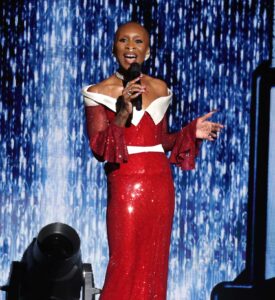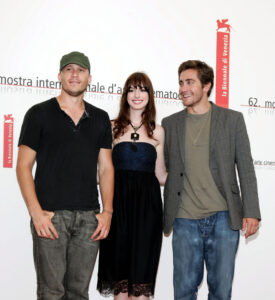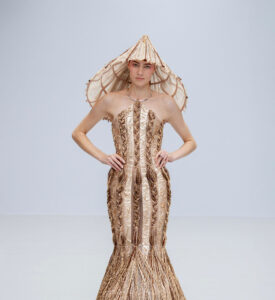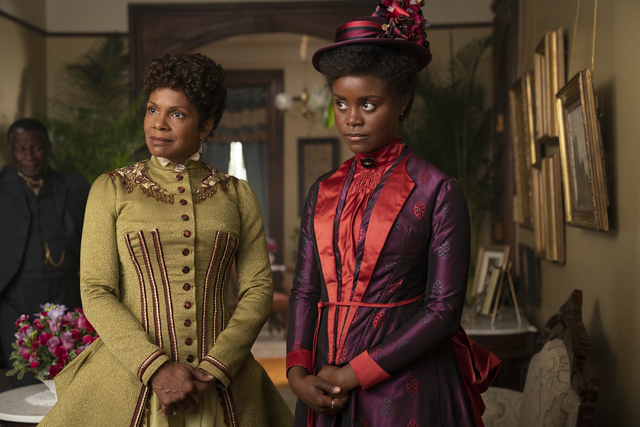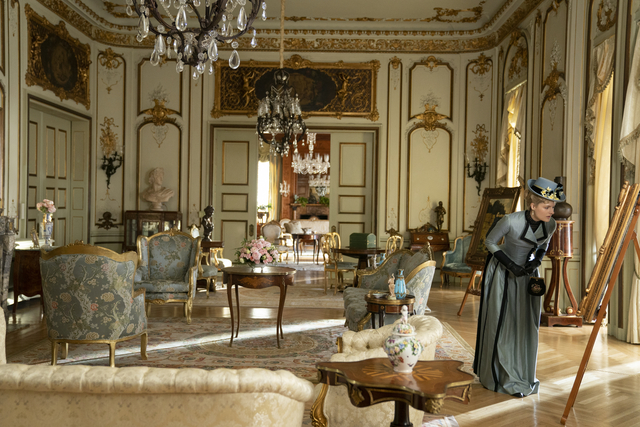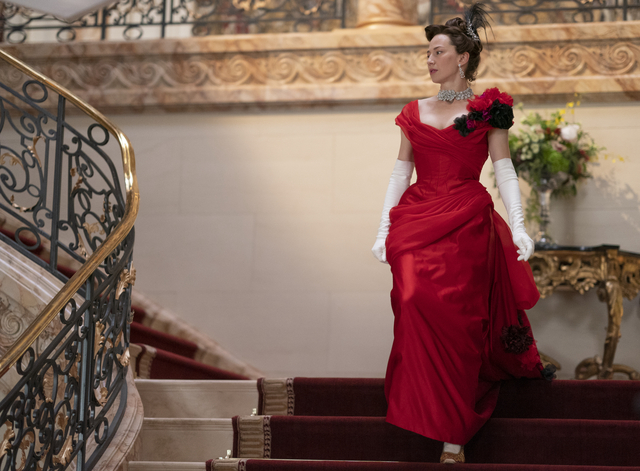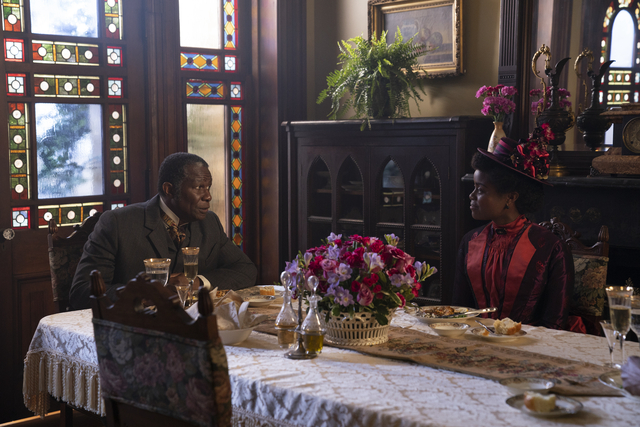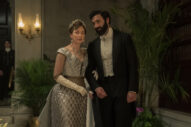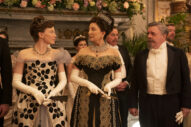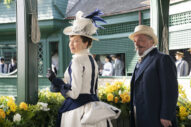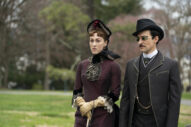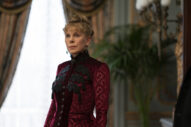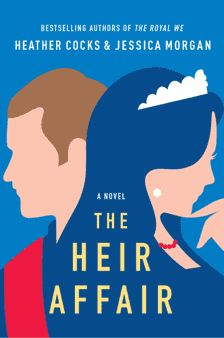Apologies for the fact that this recap is a day later than usual! My two most time-intensive features here — this, and the figure-skating coverage -- crashed into each other this week. Hopefully, these sexy robber barons and deep dives were worth the wait!
So, without further ado, let’s dive into the lives of the Upper East Siders, in an episode which opens with poor Adlerman Morris being buried while Mrs Morris dresses like Queen Victoria and people are snobs about him being buried in consecrated ground. At least mutter about that after the ceremony!
THE VAN RHIJN/BROOKS FAMILY:
I’ll start with Oscar first, since his plot is the least complicated: Now that the Russells aren’t financially decimated, Oscar is back after Gladys, which George suspects and doesn’t like because he realizes Oscar is primarily motivated by Gladys’s money. Oscar, in fact, is sort of frantic to get back in good with the Russells, but I feel like there has to be another nice naive heiress in town who he could marry. Is this all just because Oscar is lazy and the Russells are right across the street?
The other big action from the VR/Bs all circles around Marian who…does a lot of stuff this week, some of which is VERY cringe-y, and regrettable and which we will discuss when we get to Peggy and her family, as it involves them. Here, let’s talk about Marian’s other two most interesting interpersonal relationships: The one with Tom Raikes, and the one with Mrs. Chamberlain.
So, Mrs. Chamberlain runs into Marian at Bloomingdale’s while she (Mrs. Chamberlain) is buying an elaborately carved box that might be made by Grinling Gibbons from a Mr. Knoedler. “Whether it’s a Gibbons or not, the man who made this knew how to carve wood” is a line that they make Jeanne Tripplehorn deliver to Peggy (who is clearly sort of uneasy in Bloomingdale’s, the employees of which side-eye both her and Mrs. Chamberlain) and which…needed another pass. (In fairness, Grinling Gibbons DID know how to really carve a piece of wood, and I enjoyed this very petty detail from his Wiki: “Gibbons’ work very often included carvings of peapods. A myth states that he would include a closed pod in his work, only carving it open once he had been paid. If the pea pod was left shut it supposedly showed that he had not been paid for the work.”) Marian admires this well-carved but to my mind HIDEOUS box, and Mrs. Chamberlain later sends it to the house as a gift for her, without a note.
As a sidebar, the Knoedler gallery is real. It just closed in 2011 and its Wikipedia is….wild. It involves fraud, MAJOR forgeries, and selling art looted by the Nazis!
Anyway, Marian won’t tell Agnes who sent her the gift, and says she will return it and this opens a whole convo with Agnes who is basically like, “you better promise me you’re not going to run off with some unsuitable rube!” but Marian will make no such promises, because she Cannot Tell a Lie or whatever. Marian does eventually, however, tell Ada that the box is from Mrs. Chamberlain and Ada is not pleased to hear it, given Mrs Chamberlain’s Most Shocking Reputation. She and Marian have yet another conversation about marriage in which I think Marian thinks she’s making a lot of modern and progressive points about how she will marry “a gentle man,” if not a gentleman — a line I guarantee she thought of in the bath and has just been waiting to whip out — but she’s also sounding very naive and she’s kind of mean when she asks Ada if Ada might have been happier in the long run if she’d disobeyed her grandfather and married a man she fancied of whom he didn’t approve. (I feel like the show has already forgotten that Ada also kind of liked Cornelis Eckhart III! Now there’s some other Noble Poor Person she was in love with! Maybe Ada has a string of men she was only vaguely interested in.) Ada tells Marian that “marrying beneath one’s self is no guarantee of happiness” and that it would be easier for Marian to “marry someone among Mr. McAllister’s 400.” This is unromantic and not very modern — but in this time period it was also probably as true as anything else. (We will meet Mr. McAllister next week, in the form of three-time Tony Award Winner Nathan Lane, and I’m sure I’ll get into this in great detail then, but in short, The 400 was a literal list of the most important and socially acceptable New Yorkers and it was, I can assure you…..like a whole massive thing and a big-ass social draaaaama. In 2007, this would have been a blog. Oh, I guess it was. I guess it was like Socialite Rank.)
As promised, Marian returns the box, and commits the shocking social error of going inside Mrs. Chamberlain’s house, where the lady herself shows her all the amazing art that she owns.
It’s quite clear here (and I had heard this from My Sources previously) that Mrs. Chamberlain is based on Arabella Huntington, whose own personal life is very close to the way Oscar and Ada describe Mrs. Chamberlain’s: “She lived in sin for years with Old Chamberlain until his long-suffering wife finally died. Then he brought her to New York and they pretended they’d only just met.” Their son is their biological son, but Ada claims he was the child of a previous marriage that Mr. Chamberlain adopted, to make the timelines add up. In real life, all this is more-or-less true but also Mrs. Huntington eventually married her late husband’s nephew, and moved to my neck of the woods here in Southern California, where everything from our fanciest hotel to our hospital to our widest street are named after them. (I remember when the hotel was being renovated in the late ’80s, and they had a big sale of all their old fixtures in the ballroom. I bought a doorknob.) Iff you are ever in the neighborhood, the Huntington Library, Art Museum and Botanical Gardens, on the Huntingtons’ former estate, is very well worth a visit. They have a Gutenberg Bible! Anyway, Mrs Chamberlain and Marian are friends now, and you know this is gonna be a whole thing for Marian. Although I get it: Mrs. Chamberlain is nice and interesting.
Marian’s other non-Peggy story, of course, revolves around Plucky Lawyer and Man About Town Tom Raikes, whom she runs into at the symphony. She’s in a box with Aurora Fane and Bertha — Bertha got this invite because George kinda blackmailed the Fanes into being nice to her by promising to not financially ruin them if they included her more socially; usual George Russell Ride-or-Die stuff, you know — and he’s in the next one with Mrs. Henry Schermerhorn. I don’t think Mrs. Henry is a real person, but in general the Schermerhorns are FANCY. (Mrs. Astor was born a Schermerhorn IRL.) “My lady was in a high window, so I realized I needed a long ladder,” Tom tells Marian at the intermission. Again I ask: Are we supposed to buy this? Marian does, and asks him to call again and try to win her aunts over, but I can’t tell if he’s social climbing for her, or if she is just a rung on his ladder.
THE RUSSELLS:
Speaking of social climbing! Bertha is up to her usual: Wearing fancy cloaks and glamorous dresses; listening with an unimpressed look on her face when Aurora Fane tells her she’s going to get her into lunch with the aforementioned Ward “The 400″ McAllister (who, Aurora explains, both wants to see the Russell house and “loves money,” and who she calls “a henchman to Mrs. Astor”); and firing Gladys’s drunk governess for taking her to a hotel to meet a young man, then having a mild disagreement with George about whether or not it’s time for Gladys to come out. (George says yes, Bertha needs to wait for the most opportune time socially; I agree with those of you who think Gladys is going to get a title out of this.) For what it’s worth, I would also fire that governess. You are not allowed to steal my booze and allow my child to sneak out of the house to meet her random boyfriends!
Bertha also is in the midst of finagling herself onto the board of the Red Cross, after pointing out to George and one of his advisors at George Russell’s Railroads ‘n’ More that they should get involved with a charity that helps people who have suffered from disasters, due to the fact that Railroads ‘n’ More have a lot of disasters. If nothing terrible happens, they will look benevolent, but if one of their trains crashes disastrously, they’ll get immediate help! Win-win. George thinks this is brilliant and Bertha thinks George thinking she is brilliant is hot.
George, in fact, thinks Bertha is so hot and so brilliant that he has no problems turning down the frankly PSYCHOTIC overtures from her lady’s maid Turner, who continues to act like she’s a person who might also have some orphans tied up in the basement. All her fellow staff members clearly hate her, including the chef, Monsieur Baudin, who finally basically tells her that she is VERY TIRESOME AND MEAN, and their butler, Church, who spends a LOT of time staring at her with disapproval. Anyway, one night Turner gets totally naked and literally sneaks into George’s bed while he is sleeping. This is very, very inappropriate behavior, especially because he has never given her any sign he’d be into this, but even if he had. He, of course, thinks she is Bertha briefly, then leaps out of bed and informs her that this is never gonna happen. And Turner rolls around on the bed acting as seductive as she can given that she is saddled with those horrible short bangs, and tells him things like, “I believe you need a woman who can help you become the finest and the best man that you can be,” and “haven’t you ever wanted a woman who thinks only of you?” in a very practiced tone. She has an incredibly bad read on the George/Bertha relationship, and he, in fact, tells her, “the flaw in your argument is that I love my wife,” and reads her a quiet riot act about this entire seduction attempt. He is not into it. Then she says she’s IN LOVE WITH HIM! Which is deranged. I mean, I am also in love with George Russell, but at least I recognize that I could never come between him and Bertha! Anyway, he kicks her out of his room and tells her to keep her mouth shut about this and he’ll pretend it never happened, because Bertha likes her and he doesn’t want to upset her. Oh, George. This is going to bite you in the ass! You need to TELL BERTHA. She cannot have a lady’s maid who is plotting against her and also she loves firing people
THE SCOTTS:
Finally, Peggy has a lot to do! First, on the professional front: T. Thomas Fortune (a real and incredibly accomplished person, whose Wiki is absolutely fascinating) of the New York Globe (also a real and very influential publication) has asked Peggy to write for him, so she goes over to meet him and several things happen: We get some fun and neat logistical old school printing press action; a George Parker, who I think is the publisher of the Globe, expresses some concern about their subscription numbers; Peggy’s story is being published AND she’s been hired to write 200 words about why she should align herself with a political party when she doesn’t even have the right to vote (and that is absolutely not enough words for that topic, just thinking about this is giving me agita for Peggy’s writing process); and, very importantly, T. Thomas Fortune is VERY HANDSOME and Peggy and I both almost giggle when he wipes some ink off her hand. (He’s played by Sullivan Jones, who does not yet have a Tony, but I am confident he will get there!) I hope that all of this converges so that Peggy’s path crosses with the great Black journalist Ida B. Wells at some point, as Wells eventually ended up working for the paper that was originally The Globe, and also lived with T. Thomas Fortune and his wife for a time. This is all very thrilling for everyone! Well, except maybe for Agnes, who is pleased and proud of Peggy but notes she hasn’t been technically thrilled since 1865 (presumably when the war ended)….
…and also except maybe Peggy’s father, Arthur, who makes NOISES like he’s thrilled about this at Audra McDonald’s birthday lunch at the Scott family’s extremely pretty brownstone in Brooklyn, but who also makes it clear that he’d rather Peggy stay home and work with him at the drugstore he owns, and plans to pass down to her. (Technically, Audra McDonald’s character is named Dorothy. This scene with the three of them has NINE TONY AWARD NOMINATIONS among them. SEVEN are Audra’s.) Peggy is not into this drugstore plan, and she’s also kind of unenthused when her mother starts making noise about setting her up with a friend of the family who’s just graduated from Howard with a medical degree.
Sidebar to appreciate their stained glass:
Peggy thinks she is saved by the bell when someone comes to the door as her father is talking about her taking over the drugstore, but. Ugh. Marian is there and she has brought them some old boots in a bag (!) because she assumed they were poor, simply because they are Black. No one is happy to see her and this is as powerfully awkward and awful as you can imagine. (I do not understand why Marian did not take one look at their beautiful home on a beautiful tree-lined street and realize she had read all of this wrong, but well-meaning white women do sometimes like to barge ahead with their plans to help even when those plans are wrong! She also should have figured this out from a million other previous context clues, like Peggy’s beautiful wardrobe.) Peggy is clearly hurt and offended and shocked that Marian popped by uninvited to play Lady Bountiful; Arthur has clocked exactly what is going on and naturally doesn’t like it and it is reinforcing his feelings about the wisdom of Peggy working with Agnes and Ada; Dorothy is polite but pointed and clearly a bit upset in asking what the deal is with the boots; and their maid, Miss Ellen, is VERY UNIMPRESSED. (Miss Ellen did not have a lot of screen time yet but the actress who plays her, Sandra Caldwell, is fantastic and her facial expressions are perfect.) Peggy tries to save Marian by saying that she must have thought that Dorothy knows of a charity that could use those boots, but no one really buys this excuse — Arthur, for one, points out that Manhattan has plenty of charities that need some old boots. Marian clearly wants the floor to open up and swallow her, as she should. (I actually think Louisa Jacobson was pretty effective in this scene.)
Then, Peggy and Marian go outside and Peggy is angry and hurt, as she should be. “Because we’re colored, we must be poor?” she says. “I loaned you train fare!” Marian admits she made a stupid assumption, and then she says something about how Agnes and Ada “let” Peggy live with them, and Peggy points out that they don’t let her do it, she works for them, and informs Marian that she actually doesn’t know anything about her. “I live in a different country from the one you know,” she says, waving her arm at the street — but definitely also meaning as a Black woman in America. Marian apologizes, and Peggy says, “don’t be sorry. Just stop thinking you’re really my friend.” And they part ways. I enjoy the scenes of them socializing so much, but Peggy is absolutely right about this and it’s hard to see how they will repair this relationship. This felt very realistic.
There is a great article in this week’s New York Times about the role Denée Benton played in advocating for more Black women to be involved in the show, in part, and I feel like you can see the impact of these writers and directors and producers in these scenes, which are very much presented from Peggy’s point-of-view rather than Marian’s, and the show is so much better for that than it might have otherwise been. The piece also talks a bit about how pop culture has tended to skip over this particular time period when telling stories about the lives of Black Americans, which also struck me during part of the lunch with the Scotts, when Arthur tells what begins as a funny story about one of his uncles, but which ends with the information that his loved one was an enslaved person. In that moment (and in a few lighter moments with Agnes), this episode made it very clear that the Civil War, and the time when slavery was legal in America, is still quite recent history at this point, and loomed large for many of these characters.
OTHER RICH PEOPLE OF NOTE:
I thought the personal exchanges between Aurora and Charles Fane were interesting (apparently, her dad is the one with the money, and he sort of resents this), and I also think Aurora doesn’t seem like she totally dislikes Bertha. At the least, she fakes it better than Mrs. Morris. Additionally: Thank you to those of you who corrected me last week. Charles Fane looks like Michael York, not Richard Chamberlain! That is exactly what I meant.
THE VARIOUS DOWNSTAIRS FOLKS:
In addition to Turner being a FULL TIME WACKJOB:
a) The VR/B’s butler Bannister loses Pumpkin the Dog when he (Bannister) gets distracted by a sassy grocery delivery horse. Finally, Bertha finds Pumpkin (more or less) (Agnes thinks they kidnapped him) and we get a VERY entertaining series of scenes where Bannister pokes around the Russell House with their butler, Church, and Gives Notes on how Church is doing things. Bannister is nice, so he is NICE about it but he clearly thinks the way the New Money is setting the table and what they’re doing for lunch is wrong and in poor taste. It’s really funny. There is also an entertaining conversation between Bannister and the Russell’s cook, Monsieur Baudin, about whether or not it is correct to serve chicken soup at luncheon. (“Or is it chilled?” Bannister wonders. “No. It’s hot,” Monsieur Baudin responds, as if that’s the dumbest question ever.)
b) Kitchen Maid Bridget’s plot is very obvious, although the actress is doing a good job with it: She eventually tells Mrs. Bauer (whose street gambling continues to be a thing of the past), that her mother looked the other way while a man in their life (her father, I presume, but it could be an uncle or someone else close to them) sexually abused her. Mrs. Bauer is very kind about this. I bet you money that eventually one of Bridget’s Bad Parents will show up and someone will murder them. Will it be her? Will it be Jack? We will see. Julian Fellowes loves a murder that the victim kinda deserves! Maybe the person will just be in a train disaster.
c) In the grand tradition of Julian Fellowes Valet Characters With Mysterious Secrets, Watson is spending a lot of time lurking behind trees watching people. Is he….a spy? Is he a reporter who has embedded himself among the nouveau riche for an expose? Oh, is George paying him to spy on folks for future blackmail-y reasons? That’s probably it.
OTHER FURBELOWS OF INTEREST:
a) As a white person, I definitely learned about the Harlem Renaissance, which began about fifteen-ish years after this, in school, but I don’t know much about the lives of wealthy and middle class Black New Yorkers during the Gilded Age and feels like such an interesting and rich topic. Previously, I mentioned a book that I know the producers of The Gilded Age used for research of this time period, called Black Gotham: A Family History of African Americans in Nineteenth-Century New York City, which seems like a great place to continue learning about this topic, but I would love other recommendations for non-fiction or novels if you have them!
b) Thank you to the reader who emailed us the dish that apparently the part of Bertha was originally set to be played by Amanda Peet (!), and that change in casting influenced the costuming. That’s an interesting piece in The Insider about the costumes that I think you’ll enjoy. I cannot imagine Amanda Peet in that role at all, although I think her take on it might have been good if very different.
c) It was fun to see the inside of the first Bloomingdale’s, even if they are very snooty and racist there. (I feel like they were upset about both Peggy AND Mrs. Chamberlain being there.) In an irritating development, the Bloomingdale’s Wiki begins in 1980, which is so egregious that I thought it was a typo. Even Wiki has a little note in there that is like, “someone please fix this.” (Judging from the kinda sassy talk page, there definitely USED to be historical info on there? What a very niche argument.) I also thought the show set up an interesting comparison by having Peggy accompany Marian around all-white Bloomingdale’s in the opening scene and Marian not even clocking that Peggy might feel uncomfortable in there, and then Marian showing up in Brooklyn, where she is the only white person on the street, and perhaps getting a small taste of being the only person of her race somewhere.
d) I was digging around to see if the George Parker who works at The Globe is a real person, and I think that character is an amalgamation of folks, but I DID learn about the guy of the same name who is the reason we use the phrase, “if you believe that, I’ve got a bridge to tell you,” which I did not know was because some dude fraudulently sold the Brooklyn Bridge to a bunch of folks. Wiki wisely notes that they need more details on how this scam worked and….yes, yes, they do.
Photographs by Alison Cohen Rosa/HBO
